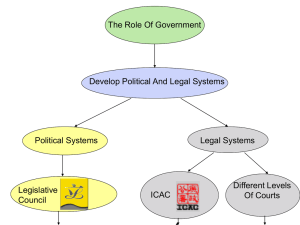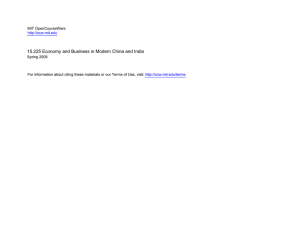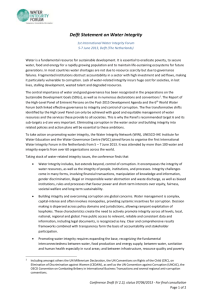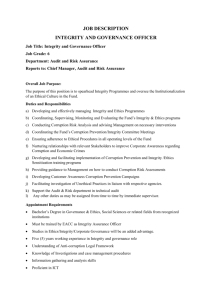Click Refresh Button. Investment Climate Reconsidered
advertisement
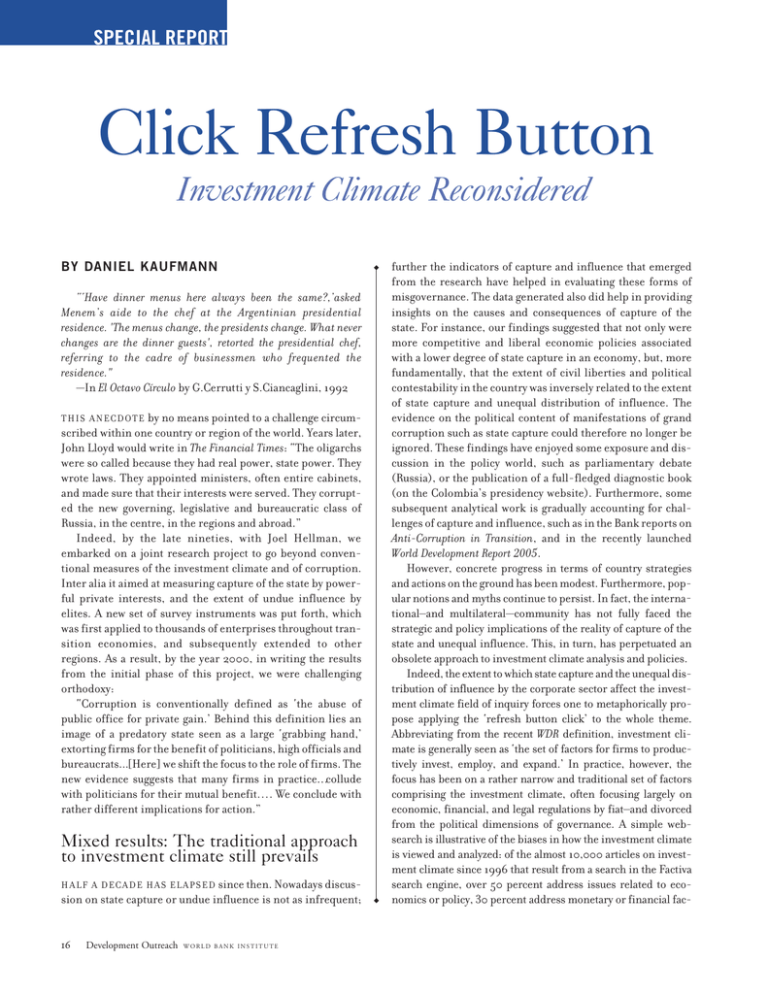
SPECIAL REPORT Click Refresh Button Investment Climate Reconsidered BY DANIEL KAUFMANN “‘Have dinner menus here always been the same?,’asked Menem’s aide to the chef at the Argentinian presidential residence. 'The menus change, the presidents change. What never changes are the dinner guests', retorted the presidential chef, referring to the cadre of businessmen who frequented the residence." —In El Octavo Círculo by G.Cerrutti y S.Ciancaglini, 1992 by no means pointed to a challenge circumscribed within one country or region of the world. Years later, John Lloyd would write in The Financial Times: “The oligarchs were so called because they had real power, state power. They wrote laws. They appointed ministers, often entire cabinets, and made sure that their interests were served. They corrupted the new governing, legislative and bureaucratic class of Russia, in the centre, in the regions and abroad.” Indeed, by the late nineties, with Joel Hellman, we embarked on a joint research project to go beyond conventional measures of the investment climate and of corruption. Inter alia it aimed at measuring capture of the state by powerful private interests, and the extent of undue influence by elites. A new set of survey instruments was put forth, which was first applied to thousands of enterprises throughout transition economies, and subsequently extended to other regions. As a result, by the year 2000, in writing the results from the initial phase of this project, we were challenging orthodoxy: “Corruption is conventionally defined as ‘the abuse of public office for private gain.’ Behind this definition lies an image of a predatory state seen as a large ‘grabbing hand,’ extorting firms for the benefit of politicians, high officials and bureaucrats...[Here] we shift the focus to the role of firms. The new evidence suggests that many firms in practice...collude with politicians for their mutual benefit. . . . We conclude with rather different implications for action.” T H I S A N E C D OT E Mixed results: The traditional approach to investment climate still prevails H A L F A D E C A D E H A S E L A P S E D since then. Nowadays discussion on state capture or undue influence is not as infrequent; 16 Development Outreach WORLD BANK INSTITUTE further the indicators of capture and influence that emerged from the research have helped in evaluating these forms of misgovernance. The data generated also did help in providing insights on the causes and consequences of capture of the state. For instance, our findings suggested that not only were more competitive and liberal economic policies associated with a lower degree of state capture in an economy, but, more fundamentally, that the extent of civil liberties and political contestability in the country was inversely related to the extent of state capture and unequal distribution of influence. The evidence on the political content of manifestations of grand corruption such as state capture could therefore no longer be ignored. These findings have enjoyed some exposure and discussion in the policy world, such as parliamentary debate (Russia), or the publication of a full-fledged diagnostic book (on the Colombia’s presidency website). Furthermore, some subsequent analytical work is gradually accounting for challenges of capture and influence, such as in the Bank reports on Anti-Corruption in Transition, and in the recently launched World Development Report 2005. However, concrete progress in terms of country strategies and actions on the ground has been modest. Furthermore, popular notions and myths continue to persist. In fact, the international–and multilateral—community has not fully faced the strategic and policy implications of the reality of capture of the state and unequal influence. This, in turn, has perpetuated an obsolete approach to investment climate analysis and policies. Indeed, the extent to which state capture and the unequal distribution of influence by the corporate sector affect the investment climate field of inquiry forces one to metaphorically propose applying the ‘refresh button click’ to the whole theme. Abbreviating from the recent WDR definition, investment climate is generally seen as ‘the set of factors for firms to productively invest, employ, and expand.’ In practice, however, the focus has been on a rather narrow and traditional set of factors comprising the investment climate, often focusing largely on economic, financial, and legal regulations by fiat–and divorced from the political dimensions of governance. A simple websearch is illustrative of the biases in how the investment climate is viewed and analyzed: of the almost 10,000 articles on investment climate since 1996 that result from a search in the Factiva search engine, over 50 percent address issues related to economics or policy, 30 percent address monetary or financial fac- with the data collected in 1999 on transition economies already gave a clear sense of the cost of state capture: countries in transition that fell into the trap of a high degree of state capture were experiencing an overall growth rate for firms of only one-half the rate of those that had embarked in a path towards a competitive market economy. Yet the ‘captor’ firms in the highly captured economies did benefit privately—explaining why capture is likely to persist— at the expense of the rest of the enterprise sector, and thus at a very large socio-economic cost. More recently, thanks to the enterprise surveys carried out by the World Economic Forum (WEF) for the Global Competitiveness Report (GCR), we have analyzed the extent to which governance and corruption constitute one of the most important constraints to business development and to competitiveness. In particular, we probed into the views of the firm about the main constraints they face. The results indicate that the most acute constraints for emerging countries were corruption, bureaucracy, policy instability and financing, while for the wealthy countries of the OECD they were labor regulations, bureaucracy, and taxation. In terms of broader clusters, the governance cluster, comprising corruption and bureaucracy, emerges as the most binding constraint, on average, worldwide, named as one of the top three constraints by firms in 79 out of the 105 countries surveyed in 2004. We also asked the question of what constraints to business, as seen by the firm itself, appear to matter in particular for the country’s competitiveness. For this, we related the firm answers to the business constraints questions mentioned above with the WEF’s Growth Competitiveness Index (GCI), which rated the relative competitiveness of all the surveyed countries. The results, which control for other factors, shown in Figure 1, are telling regarding the importance of tackling corruption in order to improve a country’s competitiveness. A country that manages to reduce the extent of corruption as an obstacle to business by one standard deviation can expect on average, to move up about 30 rank positions in its global competitiveness standing (among 105), dominating the payoff of alleviation of any other obstacle to business operations. THE RESEARCH CARRIED OUT 30 25 20 15 10 5 0 Fin For Lab anc eig or nC ing Reg urr ula enc tion yR s egu lati Infr o n ast s ruc Edu cat Bur tures ion eau of cra the cy Wo rkf Wo orc rkf e or Pol ce Eth icy ics Gov ins ern tab me ilit nt y Ins tab ilit y Cri me Cor rup Tax t i on Reg ula tion s Tax Rat es Infl atio n Governance and corruption impact on competitiveness and the investment climate. FIGURE 1: GAINS IN THE COMPETITIVENESS RANKING BY TACKLING THE BUSINESS CONSTRAINTS IMPROVEMENT IN THE GCI RANKING tors, almost 20 percent address issues related to law or legal matters, yet less than 10 percent bring up issues related to corruption or governance. As a result of the traditional approach to the investment climate, ill-advised policies continue to be put forth. Examples abound: adopting yet another myriad of regulations, or officially decreeing that a firm should be able to register its operation within a certain time frame, or drafting new anticorruption laws, or creating yet another investment promotion agency or anticorruption commission. It is thus warranted to put forth salient unresolved issues at the core of the governance-investment climate nexus. Source: Constraints to Business data based on EOS 2004 (Question: “From the following list, please select the five most problematic factors for doing business in your country, and rank them from 1 to 5.”); GCI based on GCR calculations for 2004/2005; GDP per capita from World Bank. Gains in competitiveness based on regression estimates of the impact on the GCI of an improvement in the constraint by one standard deviation. Unbundling corruption matters A S S U G G E S T E D , the undue focus until not long ago on “petti- er” forms of administrative bribery ought to give way to the need to address explicitly the costly challenges of “grander” forms of corruption, such as the tendency by elite firms and conglomerates to shape illicitly the formation of the state laws, policies, and regulations, which we have referred to as state capture. Until recently, however, these more political and “grander” forms of corruption were not regarded as subject to measurement. Through surveys we pointed to the extent of state capture by some elite firms (including some with foreign interests) and to their substantial socioeconomic costs and consequences. More recently, based on the WEF survey, Figure 2 below suggests that nowadays it is possible to unbundled the various measures of corruption and related misgovernance components. From this evidence it is clear that there are many countries in most parts of the world where the challenges of state capture as well as undue influence (proxied in this case through political financing influence), are dominant. Who shapes the business policy environment?: Investment climate ‘takers’ and ‘makers’ A FA L L AC Y T H AT S T I L L P E R S I S T S TO DAY is the presumption that the state is almighty in shaping the investment climate— and thus seen as the investment climate “maker”—while the atomic and powerless enterprise sector is viewed as the passive investment climate “taker.” In reality, powerful corporations often exert enormous influence over public policy, public institutions and officials, and particularly so in weak states. Even in M A R C H 2 0 0 5 17 strong states, such as those in rich OECD countries, powerful conglomerates can have significant influence in shaping regulatory policy, for instance. Consequently, it is paramount to revisit the traditional notions of the investment climate. The current WDR has made an important contribution inter alia by aptly placing center stage the private sector as a potentially key contributor to economic development. While it argues that the size of the enterprise sector contribution largely depends on how government policies and behaviors shape the investment climate, it does at least recognize the role played by segments of the corporate sector in shaping the investment climate as well, often in collusion with segments of the political elite, or in more extreme cases, by capture of key institutions. However, this perspective needs to be deepened and shared throughout the investment climate literature. FIGURE 2: UNBUNDLING GOVERNANCE—SELECTED COMPONENTS: VIEW OF THE FIRM, 102 COUNTRIES PERCENT OF FIRMS RATING CONSTRAINTS AS DISSATISFACTORY Administrative Bribery 0 OECD ■ ■ 18 Development Outreach WORLD BANK INSTITUTE East Asia (NIC) East Asia dev. Former Soviet Union Eastern Europe South Asia Sub-saharan Latin Africa America/ Caribbean Source: EOS 2003, GCR of WEF, author’s calculations. Each region has the following number of countries: OECD: 23; East Asia (Developing): 6, East Asia (NIC): 4; Eastern Europe: 14; Former Soviet Union: 2 (Russia and Ukraine); South Asia: 4; Sub-Saharan Africa: 21; Latin America and Caribbean: 21. T H E I M P L I C AT I O N O F T H I S N E W A P P R OAC H is that much more focus is needed on strategies encompassing effective external accountability, transparency, and prevention in order to mitigate capture and undue influence, and thus to improve the investment climate. Particular measures, increasing the cost of bribery and capture by the private sector are also needed. In particular, the following areas deserve concrete emphasis in the next stage: Transparency is crucial—with the support of rigorous data gathering and monitoring, and improved disclosure and access for financial and budgetary data, scaling up in the adoption of e-governance tools (such as e-procurement), as well as transparent disclosure of parliamentary votes and public officials’ assets. More transparency is also needed in publicly disclosing the debarred firms from international bidding due to corruption, as the World Bank has done. Accounting for the political forces affecting the particular forms of capture and undue influence in a country, which among others imply modernization and competition of party politics, and transparent political and campaign financing. Rethink orthodoxy on legal and judiciary reforms. Where the forces of capture have penetrated the judiciary it is warranted to abandon altogether traditional programs of technical assistance, such as caseload management or superficial study tours. Fundamental reforms focusing inter alia on political and economic independence of the judiciary are instead needed. Explicit recognition of who are the shapers of the investment climate, pointing also to the importance of corporate responsibility and having a clear set of incentives for enhancing corporate ethic standards by domestic and multinational firms. Given space limitations, this is a rather partial list and ■ Illegal Political Financing 50 Policy Implications: Away from traditional public sector management ■ Bribery to Influence Laws 100 treatment of this complex topic. Continuing questioning of orthodoxy, and thus departure from the narrow confines of the traditional interpretations of corruption and investment climate, may enable a further broadening of the framework for measurement, research, analysis, and effective policies in these areas. s Daniel Kaufmann is Director of Global Programs, The World Bank Institute References Anti-Corruption in Transition—A Contribution to the Policy Debate, and Anticorruption in Transition 2—Corruption in Enterprise-State Interactions in Europe and Central-Asia 1999-2002 ACT 2 www.worldbank.org/eca Diagnóstico Acerca De La Corrupción Y Governabilidad En Colombia: Elementos Para La Construcción De Una Estrategia Anticorrupción http://www.worldbank.org/wbi/governance/colombia/pdf/col_informefinal2002.pdf Cerrutti, G. and S.Ciancaglini, 1992. El Octavo Círculo, Planeta. Hellman, J. and D. Kaufmann, 2000. “Beyond the Grabbing Hand: Facing Up to State Capture by the Corporate Sector,” in Transition (April). Online, http://www.worldbank.org/wbi/governance/pdf/grabbinghand.pdf. Hellman, J., G. Jones, and D. Kaufmann, 2003. “Seize the State, Seize the Day: State Capture, Corruption , and Influence in Transition Economies,” Journal of Comparative Economics. Online, http://www.worldbank.org/wbi/governance/pubs/seizestate.html Hellman, J. and D. Kaufmann, 2003. “The Inequality of Influence,” in Trust in Transition. J. Kornai and S. Rose-Ackerman, eds. Kaufmann, Daniel, 2002. “Rethinking Governance: Empirical Lessons Challenge Orthodoxy,” in the Global Competitiveness Report, World Economic Forum, Oxford University Press. Online, http://www.worldbank.org/wbi/governance/pubs/rethink_gov.html. Kaufmann, Daniel, 2004. “Corruption, Governance and Security: Challenges for the Rich Countries and the World,” in Global Competitiveness Report, McMillan. Online, http://www.worldbank.org/wbi/governance/pubs/gcr2004.html. Lloyd, John, 2000. The Financial Times (August 5). World Bank, 2004. World Development Report 2005: A Better Investment Climate for Everyone. New York: The World Bank and Oxford University Press.
